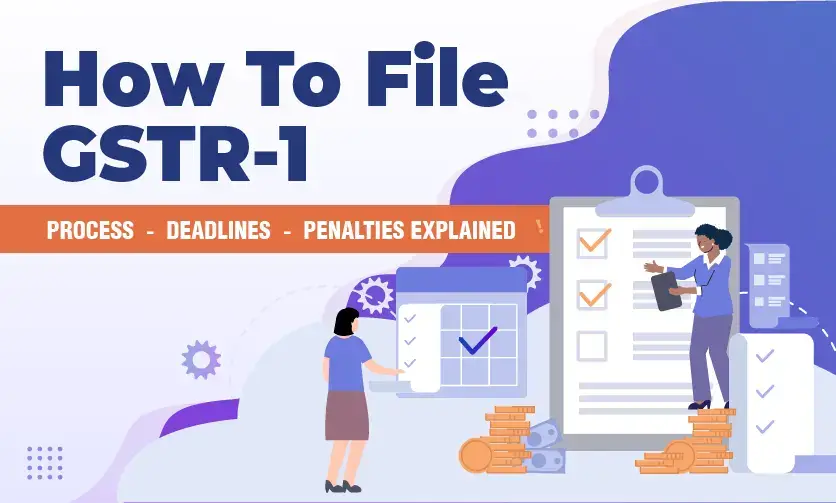
How To File GSTR 1: Process, Deadlines & Penalties Explained
After the introduction of GST in the Indian tax system, it has completely transformed the tax structure of India. With time, it is evolving a lot, and understanding its complexity and process is necessary to stay compliant. One of the most important parts of GST is understanding how to file GSTR 1 on a monthly (or quarterly) return.
Whether you have just started your business or are running it for the long term, understanding how to file GSTR 1 is mandatory for ensuring smooth business operations.
Yes, We are here to help you learn the key concepts of how to file GSTR 1, penalties and late filing fees, requirements for GSTR 1 return filing, and much more. Get ready to learn the step-by-step process of how to file GSTR 1, but first, understand what GSTR 1 is.
Table of Contents
What is GSTR-1?
In simple terms, GSTR 1 can be defined as a monthly or quarterly return that taxpayers have to file for all the outward supplies of goods and services. It reflects all the details related to the outward supply, like invoice number, taxable value, and tax amount of supplies made to registered/unregistered entities and end users or consumers.
To stay compliant with the GST laws, every business has to file GSTR 1. Before moving on to the process of how to file GSTR 1. It is important to know who should file GSTR1.
Who should file GSTR-1?
Unless you fall under a specific exemption category, filing GSTR-1 is mandatory for all normal and casual GST registrants. This includes businesses engaged in:
- Selling goods and/or services, from necessities to high-end luxuries.
- Making exports, and showcasing its products and services to the international market.
- Receiving supplies through the reverse-charge mechanism, where the recipient is responsible for paying GST.
If you’re unsure about your filing obligation, consult a tax professional or visit the GST portal for clarification.
Requirements for filing GSTR-1
There are many documents required to file GSTR-1. We have listed all these here so that you will not miss anyone.
- Active GST Registration: The first requirement is that you have to complete and activate your GST registration process so that you can file a return from there.
- Valid Digital Signature Certificate (DSC) or Electronic Verification Code (EVC): Taxpayers have to create digital signatures or provide OTP for EVC, that ensure the authenticity and security of their return.
- Correct Login Credentials on the GST Portal: Make sure you have saved your login credentials, such as ID and password because it gives you entry in the return filing process.
- Accurate Details of Outward Supplies: Always keep all the details, like recipient GSTIN, invoice value, tax rate, and HSN code, for each transaction.
- Reconciliation with GSTR-3B: Ensure your GSTR-1 data aligns with your GSTR-3B (summary return) filed for the same period. If you find any mismatch then make the required amendment/change for rectification and compliance.
If someone fails to file the GSTR 1 due to any reasons like having no idea how to file GSTR 1, or have forgotten to file within the time limit. Whatever the reason is, it results in a penalty. Let’s go through the late filing fees and penalties associated with it.
These are all the basic concepts of GST that every student and GST expert has to know. There are many more such topics that you can explore here:
Late Fees and Penalty for GSTR-1
The Late payment fee is calculated based on tax liability. Always try to complete the GSTR1 return filing on time to avoid late fees on taxes. In the below-mentioned table below, we have mentioned the late fee for GSTR 1 return filing.
| Name of the Act | Late fees for every day of delay | Maximum late fee (up to Rs.1.5 crore) | Maximum late fee (Rs.1.5-5 crore) | Maximum late fee (over Rs.5 crore) |
|---|---|---|---|---|
| CGST Act, 2017 | Rs 25 | Rs 1,000 | Rs 2,500 | Rs 5,000 |
| Corresponding State/UT GST Act 2017 | Rs 25 | Rs 1,000 | Rs 2,500 | Rs 5,000 |
| Total late fees to be paid | Rs 50 | Rs 2,000 | Rs 5,000 | Rs 10,000 |
In the next table, a late fee of nil GSTR 1 filing is mentioned
| Name of the Act | Late fees for every day of delay | Maximum late fee |
|---|---|---|
| CGST Act, 2017 | Rs 10 | Rs 250 |
| Corresponding State/UT GST Act 2017 | Rs 10 | Rs 250 |
| Total late fees to be paid | Rs 20 | Rs 500 |
Now we are going to explain the step-by-step process of how to file a GSTR 1 return. Try to go through each step carefully to understand how to file GSTR 1 online to help you with finance management.
If you are interested in exploring more in-depth concepts of how to file GSTR1, the GST registration process, or anything related to GST, then explore the courses here

How to file GSTR-1
Let’s go down the below-mentioned steps for how to file a GSTR 1 return easily:
- Login to the GST Portal: First, log in to your GST portal by entering the saved credentials.
Navigate to “Returns” and choose “GSTR-1”: Once you log in, move to the return section and choose the path GSTR 1. Here, you can file monthly or quarterly sales details. - Select the filing period (month or quarter): There are two options available here to choose from, monthly or quarterly. Select the time frame that suits your business needs.
- Choose the filing method (Online/Offline): Two options are available to file the return online or offline(in limited cases). Select your preferences according to your business.
- Fill in the required details: Now it is time to fill in all the details that are needed to file the GSTR 1 return
- Your Business’s GSTIN: Enter the GSTIN number that you have received after completing GST registration and your turnover for the previous year.
Taxable Outward Supplies: Fill up all the specific details of your outward supplies, like the invoice number and date for each transaction. - Recipient GSTIN: Make sure to enter the correct GSTIN number of your recipient.
- HSN code: Businesses must enter the HSN codes according to the types of goods or services.
- Total Value, taxable value, GST rate with IGST, CGST, SGST, and Cess of respective HSN are also filled.
- Tax rate: Indicate the applicable GST rate (e.g., 0%, 5%, 18%, etc.).
- Tax amount: Based on the tax rate, calculate the tax value that needs to be paid.
- Exports Details (if applicable): If there are any international sales, then make sure to add that also in the GSTR1 return filing.
- Taxable Inward Supplies Received through Reverse Charge: List supplies where you paid GST directly, like imports.
- Amendments (if any): Cross-check all the details that you have filled out on the GSTR 1 return form.
- Your Business’s GSTIN: Enter the GSTIN number that you have received after completing GST registration and your turnover for the previous year.
- Review the information carefully and upload any supporting documents (if required): Check all the given details to avoid any errors in the GSTR 1 return form and submit the supported documents if required, like invoices or purchase orders.
- Submit the return with EVC or DSC: Provide your digital signature to authenticate the return or OTP for verification.
- Keep a copy of the acknowledgment: Submit and save the e-filing confirmation for future reference.
NIL GSTR 1 – It can also be filed by giving an SMS by the registered mobile number of the taxpayer.
We hope, to some extent now, it’s clear to you how to file GSTR 1. The process may seem complex in the beginning, but the different software and tools available now make it easy.
Let’s explore a few more articles on GST here for knowledge enhancement.
When is GSTR-1 due?
Your GST registration type will determine the deadline for your GSTR 1 return filing. In the below section, we have mentioned the due date for GSTR 1 return filing:
- Monthly Filers: If you file your GSTR1 return monthly, then do it by the 11th of every month following the tax period.
- Quarterly Filers: If you file a GSTR 1 return quarterly, complete this by the 13th of the month following the end of the quarter.
Always ensure to file the return timely to reduce the chances of penalties and any tax compliance.
How the QRMP scheme affects GSTR-1 filing deadlines
The QRMP scheme, which stands for Quarterly Return Filing and Monthly Payment of Taxes, reduces the frequency of GSTR-1 filing, but taxpayers have to maintain monthly tax payments.
Let’s check the conditions when it affects the deadlines for tax payments based on business turnover:
For businesses with a turnover of up to Rs. 5 crores
- Without QRMP: If you do not come under the QRMP scheme, then complete your GSTR-1 return filing by the 11th of the next month.
- With QRMP: If you follow the QRMP scheme, then file your GSTR-1 return by the 10th of the month following the relevant quarter.
For businesses with a turnover above Rs. 5 crores
- The taxpayers have to file the GSTR-1 monthly by the 11th of the next month. The QRMP scheme does not affect them.
QRMP allows taxpayers to file GSTR 1 on a monthly basis, but you still need to make tax payments based on your monthly liability.
IFF for the QRMP scheme
Invoice Furnishing Facility (IFF):- This facility is available for QRMP taxpayers. They have an option to file their outward supplies details in the first 2 months of the quarter which passes the GST tax credit to the recipient.
This is not mandatory. The QRMP taxpayer can file all the supplies in the 3rd month datewise (without using IFF).
Looking to learn something that upgrades your knowledge and skills? Read some more GST-related articles here
Conclusion
We have tried to explain the complete process of how to file GSTR 1 returns accurately. Meanwhile, the process of filling may seem complex sometimes. In that case, ensure to cross-check every detail carefully for error-free filing.
If you have read the guide carefully, then, We hope that you don’t have any more queries on how to file GSTR 1. Always remember one thing, timely GSTR1 return filing is crucial for maintaining GST compliance and avoiding penalties.
- Top 20 Journal Entries Questions And Answers For Interview - November 8, 2024
- Accounts Payable Process in SAP: Step by Step Guide - August 23, 2024
- Capital and Revenue Transactions: Understand the Basics - August 16, 2024

.jpg)






















